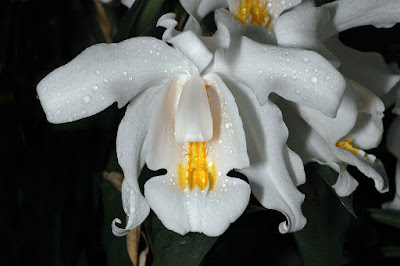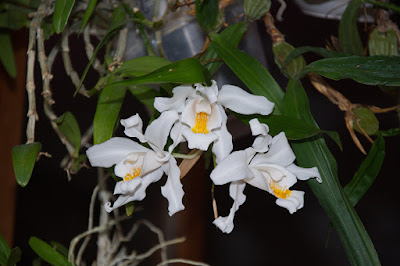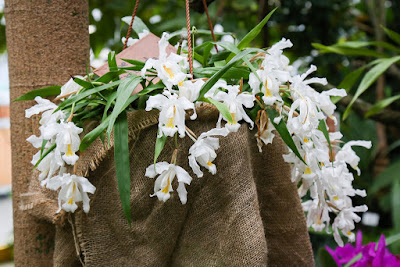Coelogyne cristata is native to eastern Himalayas and Vietnam. Their natural habitat extends east from 75 ° longitude in the Garhwal region of northern India, through Nepal, Sikkim, Assam, Bhutan, up to Khasi Hills in northeastern India...
Coelogyne cristata also called as The Crested Coelogyne, Coelogyne cristata f. hololeuca, Cymbidium speciosissimum, Pleione speciosissima, is a species of the genus Coelogyne. This species was described by John Lindley in 1821.
IDENTIFY COELOGYNE CRISTATA
Coelogyne cristata is native to eastern Himalayas and Vietnam. Their natural habitat extends east from 75 ° longitude in the Garhwal region of northern India, through Nepal, Sikkim, Assam, Bhutan, up to Khasi Hills in northeastern India. They are also grow in the mountains of northern Thailand. These habitats are usually located at heights of 1600-2600 m, in humid forests, and these plants are found both on trees and on rocks, often exposed to direct sunlight.
It is a small to medium sized, cool to cold growing epiphyte and occasional lithophyte, which reaching 15-30 cm in height, with oblong, smooth, clustered to well spaced, 5 cm long pseudobulbs carrying 2, apical, plicate, 3 to 10 nerved, narrowly lanceolate, sessile, acute, slightly undulate, 3 cm in width and 10-20 cm in length leaves.
The Crested Coelogyne blooms on a terminal, pendulous to semi-erect, 15 to 30 cm long, racemose, 3 to 10, fragrant flowered inflorescence with persistent bracts arising basally on a mature growth and occurring from mid-winter till spring. The flowers are 7-13 cm in diameter, they are often fragrant, and if they are kept dry and cool, they can last 4-5 weeks. All parts of the flower are snow-white, with a crystalline texture, and have undulating edges with curved ends. On the lip there are 4 to 5 decorative yellow combs, as well as golden-yellow spots.
COELOGYNE CRISTATA CARE AND CULTURE
Cultural information should only be used as a guide, and should be to be adapted to suit you. Your physical location; where you grow your plants, how much time you have to devote to their care, and many other factors, will need to be taken into account. Only then can you decide on the cultural methods that best suit you and your plants.
Light:
Coelogyne cristata needs a light level of 20000-30000 lux. They need shading from spring to autumn, but the light should be as much as the plant can bear without burning the leaves. Constant air movement is very important.
Temperature:
It is a plant with moderate to cold requirements. The average temperature of the summer day is 21-24 ° C, night 14-15 ° C, which gives a daily amplitude of 6-9 ° C. The average temperature of the winter day is 11-13 ° C, and the night 2-4 ° C, the daily amplitude is 8-9 ° C.
Humidity:
The Crested Coelogyne needs the humidity of almost 85% in summer and early spring, falling to 60-70% at the beginning of winter.
Substrate, growing media:
Coelogyne cristata grow well attached to pieces of tree fern or cork, but during the hot and clear summer days it requires high humidity and several waterings during the day. These plants are also planted into flat containers or baskets, using a loose, fast-drying substrate. Small or medium bark, tree fern fibers or mixtures with various additives such as charcoal, perlite, or cut sphagnum moss are often used as substrates.
You can grown in mesh baskets with 6 mm mesh, lined with coconut fiber or sphagnum moss. The substrate contains, in equal parts, fine and medium-sized tree fern fiber with the addition of 10% fine charcoal, 10% perlite or pumice, and 10% chopped sphagnum or moss. With a strong air movement, this mixture allows even shedding, because the substrate does not soak or dry completely between watering. Ferns of tree fern do not undergo too rapid decomposition, which means that it is not necessary to over-fertilize too often.
Repotting:
When the plant grows out of the basket, it can be completely repotted to a larger one without disturbing the roots. This is important because Coelogyne cristata do not like repotting and after repotting or dividing can recover for 2-3 years.
It is recommended cutting old pseudobulbs instead of repotting, if the substrate is not very spread. If repotting is necessary, make sure that new roots are already beginning to grow. This allows the plant to rooting as quickly as possible.
Watering:
These plants need to be watered abundantly during the period of active growth with easy drying between waterings. When new growths reach maturity in autumn, the amount of water gradually decreases.
Fertilizer:
During the period of strong growth, the plants should be fertilized every week with 1/4-1/2 of the recommended dose of fertilizer for orchids. You can use fertilizers with reduced nitrogen content in the late summer and autumn period, and increased phosphorus to improve flowering in the next season and strengthen new growth before winter.
To avoid the accumulation of mineral deposits during periods of strong fertilization, it is recommended to rinse the containers approximately every month. Rinsing is particularly important where the water is highly mineralized.
Rest period:
A cool and dry resting period is essential for healthy growth and flowering. When new growths reach maturity in autumn, the amount of water supplied decreases gradually, and in the winter only small occasional watering or morning spraying is enough. The amount of water can be increased when we notice the drying of the tips of the youngest leaves or when the pseudobulbs become wrinkled excessively. Leaves on older pseudobulbs may naturally die in this period, but the ends of the youngest should remain green. A small wrinkle can also occur on the newest pseudobulbs. Over wrinkles indicate a shortage of water, while its lack, i.e. excess water, may cause the plant to not bloom. Fertilization should also be reduced or even eliminated until spring, when it returns to more abundant watering.















COMMENTS